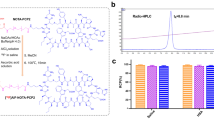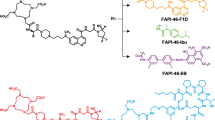Abstract
A novel heptacoordinating ligand consisting of a thirteen-membered tetraazamacrocycle containing the pyridine ring and bearing three methylenephosphonate groups (PCTP-[13]) has been synthesized. Its Gd(III) complex displays a remarkably high longitudinal water proton relaxivity (7.7 mM–1 s–1 at 25 °C, 20 MHz and pH 7.5) which has been accounted for in terms of contributions arising from (1) one water molecule bound to the metal ion, (2) hydrogen-bonded water molecules in the second coordination sphere, or (3) water molecules diffusing near the paramagnetic chelate. Variable-temperature 17O-NMR transverse relaxation data indicate that the residence lifetime of the metal-bound water molecule is very short (8.0 ns at 25 °C) with respect to the Gd(III) complexes currently considered as contrast agents for magnetic resonance imaging. Furthermore, GdPCTP-[13] interacts with human serum albumin (HSA), likely through electrostatic forces. By comparing water proton relaxivity data for the GdPCTP-[13]-HSA adduct, measured as a function of temperature and magnetic field strength, with those for the analogous adduct with GdDOTP (a twelve-membered tetraaza macrocyclic tetramethylenephosphonate complex lacking a metal-bound water molecule), it has been possible to propose a general picture accounting for the main determinants of the relaxation enhancement observed when a paramagnetic Gd(III) complex is bound to HSA. Basically, the relaxation enhancement in these systems arises from (1) water molecules in the hydration shell of the macromolecule and protein exchangeable protons which lie close to the interaction site of the paramagnetic complex and (2) the metal bound water molecule(s). As far as the latter contribution is concerned, the interaction with the protein causes an elongation of the residence lifetime of the metal-bound water molecule, which limits, to some extent, the potential relaxivity enhancement expected upon the binding of the paramagnetic complex to HSA.
Similar content being viewed by others
Author information
Authors and Affiliations
Additional information
Received: 27 January 1997 / Accepted: 12 May 1997
Rights and permissions
About this article
Cite this article
Aime, S., Botta, M., Crich, S. et al. Towards MRI contrast agents of improved efficacy. NMR relaxometric investigations of the binding interaction to HSA of a novel heptadentate macrocyclic triphosphonate Gd(III)-complex. JBIC 2, 470–479 (1997). https://doi.org/10.1007/s007750050158
Issue Date:
DOI: https://doi.org/10.1007/s007750050158




